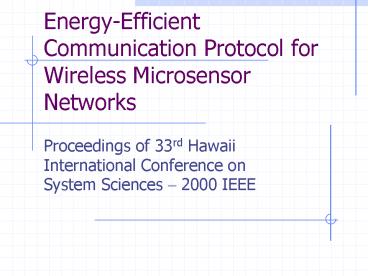EnergyEfficient Communication Protocol for Wireless Microsensor Networks
1 / 37
Title:
EnergyEfficient Communication Protocol for Wireless Microsensor Networks
Description:
To transmit a k-bit message a distance d using our radio model, the radio expends: ... The base station is fixed and located far from the sensors. ... –
Number of Views:63
Avg rating:3.0/5.0
Title: EnergyEfficient Communication Protocol for Wireless Microsensor Networks
1
Energy-Efficient Communication Protocol for
Wireless Microsensor Networks
- Proceedings of 33rd Hawaii International
Conference on System Sciences 2000 IEEE
2
Outline
- Introduction
- First Order Radio Model
- Energy Analysis of Routing Protocols
- LEACH Algorithm Details
- LEACH Low-Energy Adaptive Clustering Hierarchy
- Conclusions
3
Introduction (1/2)
- Based on protocols of direct transmission,
minimum-transmission-energy, multihop-routing,
and static clustering may not be optimal for
sensor networks. - LEACH, a clustering-based protocol that utilizes
randomized rotation of local cluster base
stations (cluster-heads) to evenly distribute the
energy load among the sensors in the network.
4
Introduction (2/2)
- LEACH is able to perform local computation in
each cluster to reduce the amount of data that
must be transmitted to the base station - This achieves a large reduction in the energy
dissipation, as computation is much cheaper than
communication
5
First order radio model (1/3)
6
First order radio model (2/3)
7
First order radio model (3/3)
- To transmit a k-bit message a distance d using
our radio model, the radio expends - To receive this message, the radio expends
8
Energy Analysis of Routing Protocols (1/7)
- Node A would transmit to node C through node B if
and only if
B
5
5
A
C
7
9
Energy Analysis of Routing Protocols (2/7)
- The direct communication approach
- In MTE routing
10
Energy Analysis of Routing Protocols (3/7)
- Direct communication requires less energy than
MTE routing if
11
Energy Analysis of Routing Protocols (4/7)
- The base station is fixed and located far from
the sensors. - All nodes in the network are homogenous and
energy-constrained
12
Energy Analysis of Routing Protocols (5/7)
13
Energy Analysis of Routing Protocols (6/7)
14
Energy Analysis of Routing Protocols (7/7)
Direct transmission
MTE routing
15
LEACH Algorithm Details (1/8)
16
LEACH Algorithm Details (2/8)
- Advertisement Phase
- n node number (total 10 nodes)
- P the desired percentage of cluster heads(e.g.,
P0.2) - r the current round ( at most 5 rounds)
- G the set of nodes that have not been
cluster-heads in the last 1/P rounds
17
LEACH Algorithm Details e.g. (1/8)
Round 0 Advertisement Phase
18
LEACH Algorithm Details e.g. (2/8)
Round 0 Cluster Set-Up Phase
19
LEACH Algorithm Details e.g. (3/8)
Round 0 Schedule Creation
20
LEACH Algorithm Details e.g. (4/8)
Round 0 Data Transmission
21
LEACH Algorithm Details e.g. (5/8)
Round 1
22
LEACH Algorithm Details e.g. (6/8)
Round 2
23
LEACH Algorithm Details e.g. (7/8)
Round 3
24
LEACH Algorithm Details e.g. (8/8)
Round 4
25
LEACH Algorithm Details (3/8)
- Advertisement Phase
- Each node that has elected itself a cluster-head
for the current round broadcasts an advertisement
message to the rest of the nodes - Each non-cluster-head node decides the cluster to
which it will belong based on the received signal
strength of the advertisement
26
LEACH Algorithm Details (4/8)
- Cluster Set-Up Phase
- After each node has decided to which cluster it
belongs, it must inform the cluster-head node
that it will be a member of the cluster - During this phase, all cluster-head nodes must
keep their receivers on
27
LEACH Algorithm Details (5/8)
- Schedule Creation
- Based on the number of nodes in the cluster, the
cluster-head node creates a TDMA schedule telling
each node when it can transmit - The schedule is broadcast back to the nodes in
the cluster
28
LEACH Algorithm Details (6/8)
- Data Transmission
- The cluster-head node must keep its receiver on
to receive all the data from the nodes in the
cluster - When all the data has been received, the cluster
head node performs signal processing fuctions to
compress the data into a single signal
29
LEACH Algorithm Details (7/8)
- Multiple Clusters
- To reduce interference, each cluster communicates
using different CDMA codes - The cluster-head then filters all received energy
using the given spreading code
30
LEACH Algorithm Details (8/8)
- Hierarchical Clustering
- The cluster-head nodes would communicate with
super-cluster-head nodes and so on until the
top layer of the hierarchy - For larger networks, this hierarchy could save a
tremendous amount of energy
31
LEACH Low-Energy Adaptive Clustering Hierarchy
(1/5)
- Normalized total system energy dissipated versus
the percent of nodes that are cluster-heads
32
LEACH Low-Energy Adaptive Clustering Hierarchy
(2/5)
- Total system energy dissipated using direct
communication, MTE routing and LEACH for the
100-node random network
33
LEACH Low-Energy Adaptive Clustering Hierarchy
(3/5)
Direct communication and LEACH
MTE routing and LEACH
34
LEACH Low-Energy Adaptive Clustering Hierarchy
(4/5)
- System lifetime
35
LEACH Low-Energy Adaptive Clustering Hierarchy
(5/5)
- Sensor that remain alive (circles) and those that
are dead (dots) after 1200 rounds
36
Conclusions (1/2)
- The key features of LEACH are
- Localized coordination and control for cluster
set-up and operation - Randomized rotation of the cluster base
stations or cluster-heads and the
corresponding clusters - Local compression to reduce global communication
37
Conclusions (2/2)
- LEACH is completely distributed, requiring no
control information from the base station, and
the nodes do not require knowledge of the global
network in order for LEACH to operate































